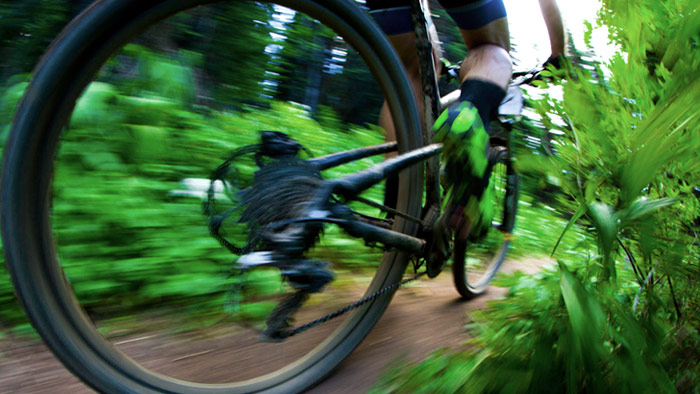Unlike road riding, there is no magical most-efficient rpm range for mountain bike racing. On the trail, you need to be great at mashing a low cadence when you have run out of gears on long steep climbs. You also need to spin a high cadence for accelerations to pass riders, accelerate out of corners and into obstacles. Spinning a moderate to low cadence is critical to maintaining traction in loose dirt and rubble and to get through a rock garden without smashing your pedals. Often times, the corners, whoops and obstacles come at you so fast and are so tightly spaced there is no time for shifting. The most efficient way through them is to stay in one gear rapping up and down the cadence range.
To optimize your off-road performance, train yourself to be efficient in a wide range of cadences. Another advantage to varying cadence when racing, is that it can keep your legs fresh if you have trained and are adapted to it.
Seated Versus Standing Cadence
Mountain bikers pedal out of the saddle more than any other types of cyclists. Moderate to low cadence is always most efficient for out-of the-saddle pedaling that lasts longer than a one to two pedal stroke power burst over an obstacle.
Use the following four workouts to train your cadence abilities for mountain bike racing.
1. Single-speeding
All mountain bikers will love this one; go single-speeding! Mountain bikers are free spirits and often prefer to just go ride rather than follow a structured workout – this time it works and nails all the goals! Single-speed riding on a mountain bike, on trails with varied terrain will cover every cadence range. Mash up the hills, rap and coast the flats then tuck and coast the downhills. Even if you don’t have a dedicated single-speed bike you can hack this workout by choosing one gear and sticking to it for a ride.
2. Big Gear Tempo Climb
Climb a 30 minute long hill at 50 to 70 rpm cadence and tempo pace (heart rate zone 3 or power level 3, about 84 to 94 percent Functional Threshold Power). Do most of the climb seated and vary cadence up and down through the 50 to 70 rpm range. Every five minutes drop cadence to 30 to 40 rpm then stand up and pedal for about 20 to 30 seconds out of the saddle. Maintain tempo pace during the standing segments. The goal of these standing segments is to freshen up while staying on pace. You will use different muscle groups, feel relief in your butt and low back and stretch your calves and hip flexors. These standing segments should feel refreshing and are not power sprints.
Single-speed specific option: Dedicated single-speed racers will benefit greatly from this session if they flip it over. Pedal standing for 30 mins at 50 to 70 rpm and tempo pace and sit down every 5 minutes for 20 to 30 seconds.
Add this session to your late base training period. If your race has very long steep climbs such as Leadville 100 and Breck Epic, include this workout in your race specific training period prior to your race.
3. Spin-Ups
In a very easy gear with light resistance, over 30 seconds, slowly increase your cadence (or spin-up) to the maximum rpm you can pedal smoothly. Focus on a quiet relaxed upper body and a fast smooth pedal stroke. If you lose form and bounce, lower the cadence, regain form then hold it. Keep the gearing easy, resistance light and your heart rate low to focus on leg speed.
8 x 30 second spin-ups to maximum rpm with good form with 3 minutes easy pedaling between each drill is a great cadence workout. Spin-ups drills can be added to any warm-up and cool-down
4. High Force Accelerations
On a gentle uphill, slow to 3 mph and pedal at 30 to 40 rpm. Then, without shifting, accelerate as fast as you can with as much power as you have until you reach maximum cadence. You should reach maximum cadence in about 6 seconds, hold it for 2 more seconds and slow down to an easy pace as you fade at about 9 to 10 seconds. Adjust your selected gearing and hill grade if needed to hit those targets. Perform 10 x 8 to 10 seconds with 3 minutes recovery after each repeat.
Use these cadence drills in your mountain bike training to expand your efficient cadence range and maximize your performance.


